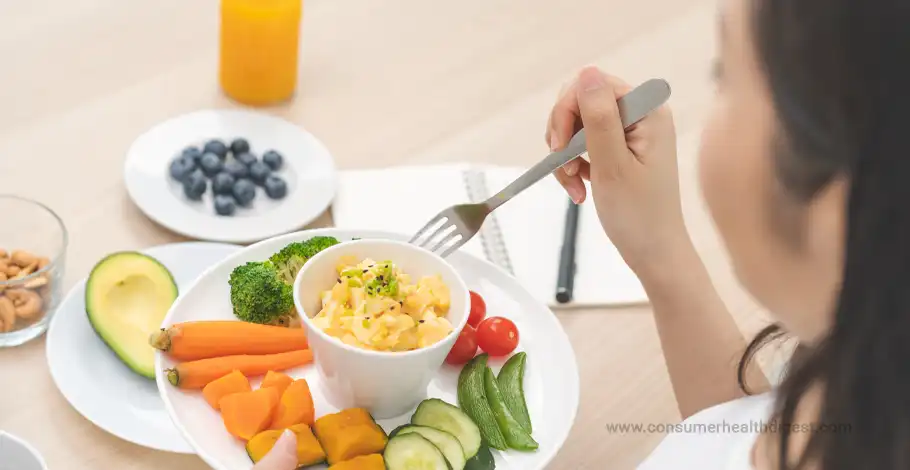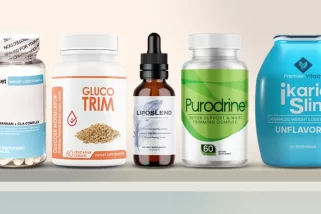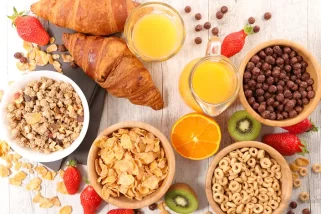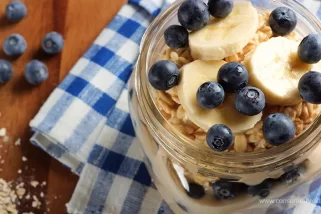In This Review
Overview
Eating more low-calorie foods is one of the most effective strategies for losing weight and improving overall health. Low-calorie foods allow you to feel full and satisfied while consuming fewer calories. This creates a calorie deficit needed for weight loss.

Opting for low-calorie foods high in nutrients means you get more vitamins, minerals, fiber, and other important compounds without excess calories. Foods like vegetables, fruits, whole grains, lean proteins, and low-fat dairy are generally low in calories but high in nutrients your body needs. They help keep you feeling full for longer, so you're less likely to overeat.
Low-calorie foods also help manage blood sugar and insulin levels, reducing food cravings. This makes sticking to a calorie-controlled diet easier for sustainable weight loss. Choosing low-calorie, whole food options is also heart-healthy. It may help lower the risk of obesity, heart disease, diabetes, and some cancers over time by aiding in achieving and maintaining a healthy weight.
What are Low-calorie Foods?
Low-calorie foods are those that contain 40 calories or less per serving. They include vegetables, fruits, whole grains, lean proteins, and low-fat dairy. These foods help with weight loss by allowing you to eat more volume of food while staying within a calorie deficit.
Feeling full on low-calorie foods means you are less likely to overeat and consume excess calories, leading to potential weight loss over time.
The Benefits of Low-calorie Foods
Low-calorie foods provide numerous health benefits beyond just weight loss. They are high in fiber, which aids digestion by preventing constipation and promoting regularity. The fiber in foods like fruits, vegetables, and whole grains helps you feel full too.
Low-calorie foods that are rich in nutrients often leave you feeling more energized as well. For example, potassium-packed bananas are known to boost energy levels. Foods with antioxidants, like different types of berries, may also increase energy by reducing oxidative stress on the body. Low-calorie snacks curb cravings and prevent blood sugar spikes that lead to energy crashes. They improve long-term heart health by maintaining a healthy weight.[1]
For the brain, low-calorie fruits and vegetables supply antioxidants that may ward off cognitive decline. Overall, a diet focused on low-calorie, nutrient-dense foods sets the foundation for improved digestion, stable energy levels, and lower disease risk.
List of Low-calorie Foods
Let’s take a look at the different types of low-calorie foods. Low-calorie foods can include various fruits and vegetables. They have several other health benefits other than weight loss. Incorporating these weight loss foods into your diet can support your overall health and wellness journey.
Top 5 lowest-calorie fruits:
When looking to add more nutritious and filling foods to your diet while staying within calorie goals, incorporating more low-calorie fruits is an excellent strategy. Some of the best low-calorie fruit options that are packed with vitamins and minerals include:
1. Strawberries
At 47 calories per cup, strawberries are one of the best low-calorie fruits you can eat. They're sweet and packed with vitamin C, vitamins, minerals, and special compounds that are great for your health. Research suggests these compounds work together to make you healthier and prevent diseases. They can fight off harmful substances in your body, control how your genes work, and even repair damaged DNA. So, strawberries are like little health superheroes![2]
2. Grapefruit
A medium grapefruit only has about 52 calories and is full of vitamin C. It's a great breakfast option. According to Johns Hopkins Medicine, grapefruit supports gut health with its fiber content, preventing constipation and promoting the growth of good gut bacteria. Additionally, its rich fiber content contributes to maintaining healthier cholesterol levels by regulating LDL cholesterol, supporting overall cardiovascular well-being.[3]
3. Watermelon
A cup of diced watermelon has a mere 46 calories but is high in lycopene and hydrating. New research found that if you eat watermelon regularly, it may help your body make nitric oxide. This may lower your blood pressure and improve blood flow in your body. It may also make your muscles work better when you do long exercises like running or biking. So, watermelon has the potential to make you feel better in an overall way.[4]
4. Blueberries
With only 84 calories per cup, blueberries are super low in calories yet full of antioxidants. They also contain a large number of phytochemicals, including abundant anthocyanin pigments. Of their various phytochemicals, anthocyanins probably make the greatest impact on blueberry health and functionality. Anthocyanins are found to have therapeutic effects on various diseases, such as circulatory, nervous, endocrine, digestive, sensory, urinary, and immune systems.[5]
5. Cantaloupe
A cup of cantaloupe cubes provides a mere 50 calories but is packed with vitamins A and C.
These five fruits are all excellent low-calorie choices that are nutritious and satisfying. Choosing fruits from this list is a great way to get more nutrients into your diet while staying within your calorie goals.
Top 5 low-calorie Vegetables
Vegetables are so good for you and can really help you feel full without a lot of calories. Here are some tasty veggie choices that are low in calories and packed with nutrients:
1. Watercress
This leafy green only has 4 calories per cup! It's full of vitamin C, vitamin K, and calcium. Watercress is shown to be loaded with antioxidants and may help prevent cancer.[6]
2. Arugula
With its slightly peppery flavor, arugula has only 6 calories per cup. It's high in vitamin K, vitamin A, and folate. Research shows it has anti-inflammatory properties too.[7]
3. Lettuce
Commonly used in salads, lettuce has about 5 calories per cup. It provides vitamin K, vitamin A, and folate. Research has found lettuce is also a good source of fiber and may reduce inflammation.[8]
4. Alfalfa Sprouts
These tiny sprouts you see in salads and sandwiches are only 8 calories per cup. They contain vitamin K, vitamin C, and folate. Studies show alfalfa sprouts are full of antioxidants and may help manage blood sugar levels and weight.[9]
5. Cabbage
Often used in Asian cooking, raw cabbage has around 17 calories per shredded cup. It's a great source of vitamin C, vitamin K, and folate. Cabbage is also high in fiber and versatile; try it in kimchi, salads, or other dishes.[10]
Other low-cal veggie options worth mentioning are broccoli, cucumber, celery, radishes, and zucchini. Cucumber and celery are mostly water, so they fill you up without many calories. The best thing is to eat a variety of fruits and vegetables daily for overall health.
Lean Protein Options
Research says there are two traditional kinds of protein sources: animal and plant. Animal-based proteins like meat, eggs, and dairy give your body all the amino acids (building blocks) it needs to make its own proteins. While plant-based proteins such as beans and nuts also have these amino acids, they might not have them in optimal proportions, so it's a good idea to consume different plant-protein sources over the course of a day.
Animal proteins have lots of vitamins and minerals, but some also have a lot of unhealthy fat, which worries some health experts more than what's in plant proteins. Let’s take a look at where you can find lean protein.[11]
1. Chicken and turkey breast
The breast meat contains minimal fat. Removing the skin further reduces fat grams and calories. Dark meat, like thighs, have a higher fat content.
2. Fish
Tilapia and cod typically have less than 5 grams of fat per cooked serving. Tuna (canned in water) is drained of excess oil. Mackerel, salmon, and other oily fish contain more total fat but are higher in omega-3 fatty acids, so they are still considered a lean, healthy protein source.
3. Eggs
Egg whites contain almost no fat or cholesterol and provide high-quality protein. Whole eggs have around 5g of fat, though the fat is mainly heart-healthy monounsaturated and polyunsaturated.
4. Tofu and tempeh
Soy-based proteins are naturally low in fat but can absorb oils during cooking. Preparing with minimal or no added oil keeps the fat low.
5. Beans and lentils
All varieties are inherently low in fat as legumes. There is no need to remove fat, unlike with meat and poultry.
6. Greek yogurt
Non-fat and low-fat varieties have the cream and milk fats strained out, leaving just the protein-rich solids.
Healthy Meal Planning Tips

Healthy meal planning is important for your overall wellness and nutrition. Planning your meals in advance allows you to choose healthier options and avoid unhealthy convenience foods. It can also save you time and money compared to last-minute, impulse purchases.
Some tips for healthy meal planning include writing a grocery list before shopping. This ensures you only buy what you need and prevents overspending on unnecessary items. It's also a good idea to plan your meals for the whole week. This keeps you accountable and less likely to stray from your healthy eating goals. When planning meals, keep an eye on portion sizes and calorie counts. Aim for balanced plates with lean proteins, whole grains, fruits, and vegetables.[12]
For breakfast ideas, try oatmeal with fruit, unsweetened yogurt, and granola, or eggs with whole wheat toast. Lunch options like chicken salad sandwiches, Herbed Chicken Salad, soups, and veggie wraps provide protein and fiber to keep you full until dinner. For dinner, some sample healthy meal ideas are baked salmon with roasted potatoes and asparagus, stir-fries with tofu or chicken over brown rice, and tacos or fajitas made with lean meat and lots of veggies. Healthy snacks between meals include nuts, fruit, unsweetened yogurt, low-fat string cheese, or raw vegetable sticks with hummus.
Conclusion
In conclusion, low-calorie foods play an integral role in maintaining a healthy weight and lifestyle. As we've discussed, choosing foods that are low in calories but high in nutrients allows you to feel full and satisfied while still cutting calories.
Eating more low-calorie fruits and vegetables, lean proteins, whole grains, and healthy fats will provide your body with lasting energy and essential vitamins and minerals. When incorporated regularly into meals and snacks, low-calorie options make it easier to create a calorie deficit and lose weight over time.
It is necessary to examine your current diet and look for opportunities to swap higher-calorie foods for lower-calorie alternatives. Even small changes like using low-fat dressings, choosing fruit for dessert more often, or loading up your plate with non-starchy veggies can have a big impact on your calorie intake. Making low-calorie foods the foundation of your meals is a sustainable approach to weight loss and optimal health. With some planning and adjustments, you too, can reap the benefits of a healthy, low-calorie diet.
12 Sources
We review published medical research in respected scientific journals to arrive at our conclusions about a product or health topic. This ensures the highest standard of scientific accuracy.
[2] Strawberry as a health promoter: https://pubmed.ncbi.nlm.nih.gov/25803191/
[3] Grapefruit Benefits: https://www.hopkinsmedicine.org/health/wellness-and-prevention/grapefruit-benefits
[4] Influence of L-citrulline and watermelon supplementation on vascular function and exercise performance: https://pubmed.ncbi.nlm.nih.gov/27749691/
[5] Anthocyanins: Promising Natural Products with Diverse Pharmacological Activities: https://pubmed.ncbi.nlm.nih.gov/34206588/
[6] Watercress: https://www.researchgate.net/profile/Mirna-Clemente/publication/334172810_International_Journal_of_Medicinal_Plants_and_Natural_Products_IJMPNP_Watercress_as_a_Functional_Food_with_Protective_Effects_on_Human_Health_Against_Oxidative_Stress_A_Review_Study/links/5d1b93c8299bf1547c92a88a/International-Journal-of-Medicinal-Plants-and-Natural-Products-IJMPNP-Watercress-as-a-Functional-Food-with-Protective-Effects-on-Human-Health-Against-Oxidative-Stress-A-Review-Study.pdf
[7] Health benefits of Arugula: https://www.iscientific.org/wp-content/uploads/2019/09/9-IJCBS-15-08-09.pdf
[8] Lettuce: https://www.researchgate.net/publication/226388756_Lettuce
[9] Alfalfa Sprouts: https://www.mdpi.com/2076-3921/10/10/1613
[10] Health Benefits of Cabbage: https://health.clevelandclinic.org/benefits-of-cabbage/
[11] Protein – Which is Best?: https://www.ncbi.nlm.nih.gov/pmc/articles/PMC3905294/
[12] Mindfulness Approaches and Weight Loss, Weight Maintenance, and Weight Regain: https://pubmed.ncbi.nlm.nih.gov/29446036/







 This article changed my life!
This article changed my life! This article was informative.
This article was informative. I have a medical question.
I have a medical question.
 This article contains incorrect information.
This article contains incorrect information. This article doesn’t have the information I’m looking for.
This article doesn’t have the information I’m looking for.